This site is best
viewed at 800x600
and 16 bit color.

* At war's doorstep :
At the beginning of 1968, the “Fuerza Aerea Salvadoreña” had only 34 qualified pilots, but seven of them were assigned to the TACA airline, two others to crop dusting duties (for which the FAS collected) and a further two, assigned to regular flights with the DC-4M-1 (FAS 300, acquired in 1967), flights in which lobster loads were flown to the city of Miami.
On the other hand, FAS “aerotecnicos” (ground support personnel) were being trained by Fuerza Aerea Guatemalteca personnel, through a rather curious method: The FAS mechanics were flown to Guatemala where they worked during the day with their Guatemalan counterparts, and at sunset, were ferried back to San Salvador.
The high degree of cannibalization of the Corsair fleet, caused the FAS commanding officers to begin looking for some kind of replacement. The answer to this need came in the form of several Cavalier Mustang aircraft, remanufactured by Trans Florida Aircraft. The batch, acquired under a special provision of the MSP program in September 1968, included a Cavalier Mustang TF-51D (FAS 400), five Cavalier Mustang IIs (FAS 401 through 405) and a Cavalier Mustang 750 (FAS 406).
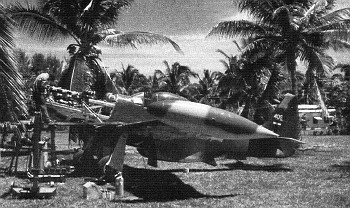
Cavalier Mustang II FAS 405 at Madre Sal Island. 1969
The first Mustang loss occurred on 8 October 1968, when FAS 402 crashed during the take-off run at Ilopango airport.
During the middle of 1969, war drums began to sound both in El Salvador and Honduras. The problem of Salvadoran peasant immigration to Honduras, and the mistreatment that these people received in that country, caused that tensions increased with every passing day. The Fuerza Aerea Salvadoreña, foreseeing a clash between the two countries, and aware of its disadvantage against the Honduran aerial power, began a frantic search for additional fighter aircraft, in order to complement their Mustang “escadrille” acquired in 1968.
By early June 1969, there were more than 300,000 Salvadoran peasants, which had crossed the border and had established themselves in the relatively sparsely populated region in the south of Honduras. The feeling of the Honduran population towards the Salvadoran “invaders” was just this side short of hate. With this state of affairs, in several occasions the Hondurans impeded the crossing of the border by Salvadorans, and as a result, there were minor altercations. To complicate matters even more, the Honduran Government began a series of changes aimed to institute a program of land distribution, purposefully leaving out the Salvadoran peasants.
Very soon, the Salvadoran territorial ambitions were felt, with the idea of claiming as “Salvadoran” those lands occupied by the immigrant peasants. Meanwhile, in San Salvador City, maps showing a country almost one and a half times larger than what it was in reality, began to circulate. Obviously, those lands that were now included in the maps, were those occupied by the Salvadoran peasants in Honduras.
* A Tragic Soccer match
The immediate cause for the beginning of hostilities, was the violence that developed in both countries, during the qualifying round for the 1970 World Soccer Cup. The first game, which matched the national teams of El Salvador and Honduras, took place in the Honduran Capital of Tegucigalpa, and won by Honduras. When the game ended, Salvadoran fans, which had traveled to support their team, complained of mistreatment in the hands of Honduran nationals. At the same time, the anti-Salvadoran propaganda increased its tempo in local radio stations. The next game took place on 15 June in San Salvador, and this time, the Salvadoran team being the winner. It was the Hondurans turn to be the target of attacks and insults from the Salvadoran population. At the same time this was happening, Honduran radio stations broadcasts exacerbated the anti-Salvadoran climate, and this caused an eruption of violence against Salvadorans residing in Honduras, producing looting, arson and persecution against the Salvadorans there. Many Salvadorans residing in Honduras had to flee towards the border and seek refuge in their country of origin.
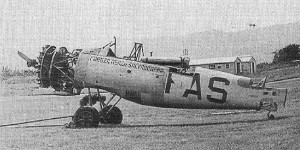
On 24 June, the Salvadoran government calls to active service all their military reserves, and finally, declares a state of emergency on the 26th. date in which diplomatic relations with Honduras are broken. Rumors began to circulate in San Salvador, about an Honduran airplane strafing the border post at “El Poy”, and about Honduran troops having crossed the border near “Cueva del Ermitaño".
The increase of tensions left no doubt that a confrontation between the two nations was unavoidable. The FAS “Comandancia” deployed “purchasing teams” to the United States, with the mission of acquiring Mustangs without regard to cost, specially those which were the property of civilians, since in light of their problems, the United States had suspended the sale of weapons to both countries. Several of these aircraft were brought into El Salvador by means of complicated, behind the scenes maneuvering, and at some time, there were several types of Mustangs headed for El Salvador, making stops in Haiti, Dominican Republic and other Caribbean Islands.
Finally, the last aircraft acquired was a Mustang P-51D-25-NA (YS-210P, ex 44-73273) the property of the Salvadoran citizen Archie Baldocchi. This acquisition was made with the argument of the situation of emergency that the country was living, and the need for combat aircraft that the FAS had. It was thus, that this Mustang became FAS 402, the second time that the serial number was utilized. At the same time, the FAS “recruited” Señor Baldocchi as an “Extraordinary Assistant” to the Air Force Commander.
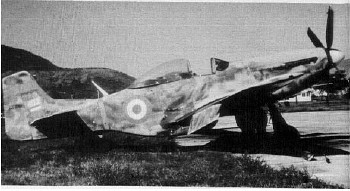
North American P-51D FAS 402 (Ex YS-210P) seen here at Ilopango during the final stages of the war.
Days before the outbreak of hostilities, the FAS had been able to gather 18 Mustangs, including the Cavalier examples, acquired in 1968. The remainder, were more or less, stock F-51Ds, which had armament installed, since they had been previously civilianized by their north American owners to comply with FAA regulations. The whole Mustang contingent was deployed to the “secret base” located at “Madre Sal” island, shortly before the beginning of hostilities.
The total FAS force, to face the emergency, consisted of 37 aircraft, as follows: Five U-17A, 18 Cavalier Mustang, five FG-1D, two SNJs, a T-34, two Cessna 180s, and four C-47s. All these aircraft conformed the “Grupo de Combate” and were organized in three squadrons: A fighter-bomber squadron (Mustangs and FG-1Ds), a Transport Squadron (C-47s, U-17As and Cessnas), and finally, a Reconnaissance Squadron (SNJs and the T-34). Other groups were those for Maintenance, Communications and Services. At the same time, the FAS had a Medical group, an Airborne company, a Support Services Battalion, and a Base Security group.
On 3 July another incident has a heavy influence over the already frayed relations between the two countries, when a Piper PA-28 Cherokee (YS-234P) is intercepted by two Honduran T-28s and forced to land.
Shortly after, the crew of the Cherokee was accused of having being captured while flying a reconnaissance mission for the Salvadoran Army. During the next few days, Honduras repeatedly accuses El Salvador of violating their air space. Finally, on 12 July, the “Fuerza Aerea Hondureña” begins operation “Base Nueva”, which consisted on the deployment of all the FAH units, to “La Mesa” AB, in San Pedro Sula. In the same location, the “Comando Norte” (Northern Command) is established, which would be in charge of coordinating all the operations during the conflict.
* Mustang Vrs. Corsair
The Salvadoran campaign to invade Honduran territories, began on 14 July, when more than 12,000 men, divided in two columns, attacked three key border posts near the cities of Nueva Ocotepeque, Gracias a Dios and Santa Rosa de Copan. The same day, the FAS begins attack and bombardment flights against Honduran troop concentrations, utilizing for this task, the FG-1Ds and the Mustangs as escort. At the same time, the C-47s are sent on several bombing missions against Tegucigalpa, and during which the bombs were rolleded out from the cargo door of the aircraft. The FAH’s F4U-5Ns are alerted on the presence of the FAS’ C-47s and take off near 18:00 hrs. However, bad weather impedes their making contact with the enemy aircraft.
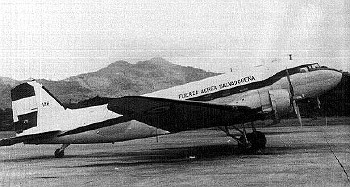
Douglas C-47 FAS 108 photographed at Howard AFB in 1975.
The C-47 missions, prove to have more of a psychologically damaging effect than a material one, since the damages caused were minimal, due in great part, to the little precision of their bombing runs.
On the 15th., the FAH organizes a retaliatory strike, and the first mission is flown by a C-47, which attacks Ilopango airport and drops over 18 bombs, but causing little damage. At 04:22, a FAH “escuadrille”, conformed by three F4U-5N and an F4U-4, commanded by Mayor Oscar Colindres, approaches Ilopango, with their landing gear and flaps down, simulating a normal approach to the runway. With this, they were trying to convince the anti-aircraft machine gunners that they were FAS FG-1Ds returning to base. Once over the runway, the aircraft broke and began their attack on the base, using bombs and rockets, but most of the weapons failed, the only exception being a 500lb. bomb dropped by Mayor Colindres, and which hit squarely one of the hangars. Not finding any opposition from the FAS, the attacking aircraft strafed targets of opportunity, resulting in the destruction of the fuel farm at “La Union” and the Standard Oil refinery in Acajutla. An F4U-5N was damaged by AAA fire, but manages to return to base in San Pedro Sula.
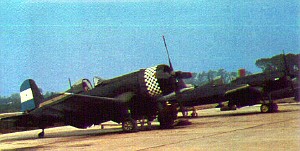
Chance Vought F4Us FAH 615 and 614 seen at San Pedro Sula, 1975.
That same day, the first FAS “Long Range” mission takes place, using a Mustang and a Corsair to attack the FAH base at Toncontin in Tegucigalpa, destroying hangars and several decoys. A FAH F4U-5N takes off from San Pedro Sula and began to pursue the two Salvadoran aircraft, but when he was behind them, the Honduran pilot found that his cannons were inoperative, and this allowed the attacking aircraft to escape to El Salvador. The Same day, the “Escuadrilla” T-28 begins their periodical flights over Tegucigalpa.

Good Year FG-1D FAS 220 ready for take off at Ilopango
* The Days of Major Soto.
The Salvadoran Army manages to occupy the city of Nueva Ocotepeque on 17 July, forcing the Honduran Army to flee. Two Mustangs are deployed to support Salvadoran troops, but they are intercepted by two FAH F4U-5Ns. During this encounter, Capitán Humberto Varela’s Mustang is shot down by Mayor Fernando Soto, becoming the last Mustang to be shot down in an air-to-air action in history.
Initially, the FAS was operating the Mustangs and FG-1Ds at 100% capacity, and many of the less important missions, included rather informal and poorly coordinated attack flights, to provide support for ground troops One of the first problems that the Mustang pilots encountered, was that of the poor maneuverability of the Cavalier aircraft, mainly due to their being equipped with wing-tip tanks. Mr. Baldocchi designed fillets to be installed on the wing tips, and thus to remove the wing-tip tanks, and provide the aircraft with more control and stability. At the same time, Señor Baldocchi designed reflective sights for those aircraft lacking them, adapted radios previously installed in Jeeps and mounted them in some Mustangs, and designed drop tanks made of fiber glass, to increase the range of the aircraft without seriously effecting the weight of the aircraft.
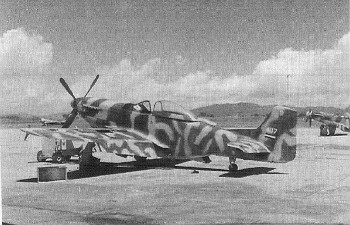
North American F-51D FAS 407. 1969
The FAS was also facing other problems, the principal being the lack of fuel, which was solved in great part by the “practice” of Salvadoran pilots, of carrying in their aircraft, the minimum fuel necessary to complete their missions. This practice brought great results, increasing aircraft maneuverability, and only caused one loss, since the TF-51D, FAS-400 had to land in Guatemala when it ran out of fuel. This aircraft was interned in Guatemala by the authorities, according to international law, and fully armed and fueled, was returned to El Salvador, once the conflict was over. The other big problem was the lack of qualified pilots, and even though reserve pilots were brought into active status, it was necessary to hire five mercenary pilots, among which were Jerry DeLarm and Red Gray.
In any case, the participation of this experienced pilots did not change the FAS performance during the conflict, and it was common to see that the mercenary pilots would not compromise their position when they encountered FAH pilots in the air. According to FAS pilots testimonies, the mercenary pilots always climbed out of reach of the Honduran F-4Us, leaving behind the Salvadoran pilots they were escorting.
On 18 July, the Organization of American States intervenes, ordering a cease-fire and the withdrawal of Salvadoran troops, but the Salvadoran government refuses to comply. Meanwhile, Salvadoran troops had penetrated over 65 Km. in Honduran territory, and the option of entering Tegucigalpa and installing a government amicable to Salvadoran interests, was being considered. During the ground support flights by the FAS, an F-51 is shot down by Mayor Soto, flying F4U-5N FAH 609. Later on, Mayor Soto would, also shoot down the FG-1D flown by Mayor Trabanino.
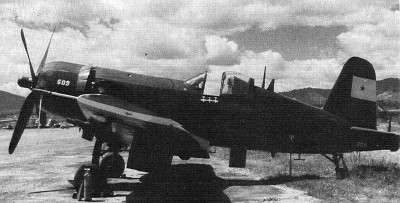
The Memorable F4U-5N FAH 609, Major Soto's Corsair
That day, Mayor Trabanino would have “the fortune” of becoming one of the last piston engine pilots to be shot down in a dogfight. According to an observer, Mayor Trabanino was an excellent aerobatics pilot, but committed the cardinal error of trying to evade Mayor Soto’s attack with these tactics. According to Mayor Soto, “it was fantastic to see those Salvadorans fly”.
The FAH concentrated its efforts then, on attacking Salvadoran Army positions. Perhaps the only exception was a mission carried over by three F4U, which attacked the Port of Acajutla. It seems that an aircraft, piloted by Capitan Walter Lopez, suffered carburetor trouble, and found himself forced to make an emergency landing in Bananera, Guatemala, where the airplane was interned. That day, the only FAH Lockheed T-33 flew several low altitude reconnaissance flights over San Salvador.
* Epilogue
On the 27, the Honduran troops launched a surprise attack on 5 Salvadoran border towns, which increases the fighting in all the conflict area. Combat continued until 29 July and because of the refusal of the Salvadoran government to withdraw its troops, the OAS declares El Salvador to be the aggressor, and imposes on this country, economic sanctions which finally cause the withdrawal of troops on 5 August. Many sources insist that during this 25-day war, the FAH lost more than eight aircraft, but it seems that these sources are wrong. It is known with certainty that no Honduran airplane was lost during the conflict, besides some inoperative AT-6 and BT-13, which were used as decoys. There is enough evidence to support the contention that, after the surprise FAS attacks to Toncontin, the FAH managed to establish and maintain control of the air in their territory. This is, perhaps, the only good thing coming out from what is considered a defeat of the Honduran forces in general.
On the other hand, the FAS, in spite of the losses, and the incredible problems it faced, managed to keep its force operational, and came out of the conflict with increased prestige, taking good part of the credit for the Salvadoran victory. By October 1969, FAS still counted with intact 13 Mustangs, of which 10 were operational, from the total of 18 acquired. Every week, and as a result of the lessons learned during the war, between two and six Mustangs were rotated to the bases at San Miguel and Santa Ana, the base at Madre Sal not being used due to problems with resupplying it. Additionally, the two surviving FG-1Ds, based at Ilopango, remained as the favorite of the Salvadoran pilots, being flown on an almost daily basis.
The end of the war, marked the beginning of an arms race between the two countries. At first, the FAS tried to increase their number of Mustangs, but the U.S. government frustrated all their attempts. Finally, the FAS manages to acquire several Dassault Ouragan surplused by the Israeli Air Force. This purchase is partially financed by the sale of the Mustangs and FG-1Ds in 1974. This one, however, is another story . . . .
Central American and Caribbean Air Forces
North American P-51 in Latin American Air Forces Service
... Y escribieron historia en el ceilo